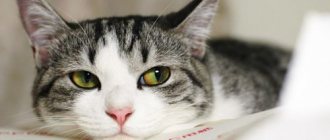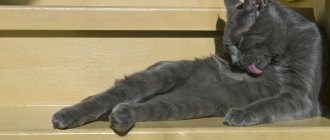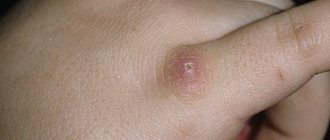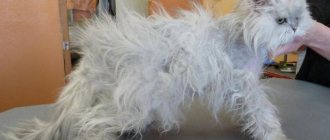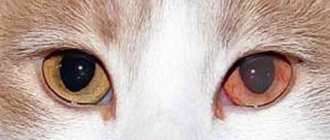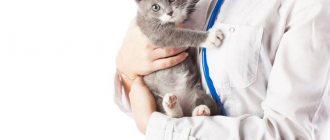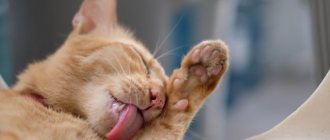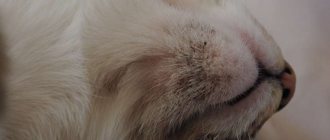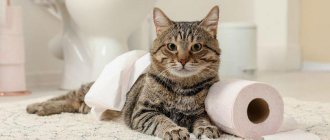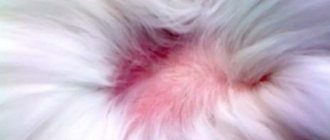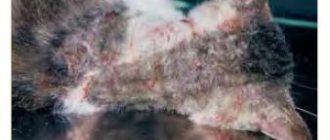Hair change in cats is a normal seasonal phenomenon, although it causes a lot of worries for owners. A shedding pet leaves fur on the furniture, which must be removed with a vacuum cleaner and brush. A healthy cat does not shed profusely; otherwise, disturbances in the functioning of the body should be suspected. The animal must be shown to a veterinarian, because severe cat shedding can be a symptom of exhaustion and systemic pathologies.
Why cats and kittens shed
Shedding is a natural process of fur renewal. Old hairs fall out of the follicles, and new ones grow in their place. Depending on the breed and living conditions of the animal, the change of coat can be continuous or seasonal. Cats of all breeds shed except hairless cats.
Seasonal molt
Cats that shed seasonally change their coat twice a year. When spring and autumn come, fur renewal is due to climate changes: by winter the animal becomes warmer, becomes fluffier, and by summer it becomes lighter. Seasonal molting lasts up to 9 weeks. In long-haired individuals it is more pronounced in spring. In short-haired cats the intensity is the same.
Sometimes a cat sheds slightly in winter, reacting to changes in weather: the arrival of frost or thaw. Same in summer.
In addition to seasonal molt, short-term juvenile molt is observed. In small kittens, the change of coat to adult begins at six months, the hairs become stiffer, the color becomes more intense, and patterns appear on the body.
Change of coat
Year-round molting
Some breeds shed throughout the year. Owners have to constantly care for their pets' fur.
Another reason why a cat sheds all year round is the lack of walking. The adapted cat's body begins to react to the temperature in the home. It’s warm in the summer, and when winter comes, the heating radiators are turned on - the thermometer readings change slightly, so at home, fur is always growing.
Cats love to walk in nature
A little about molting
Changing coats is a necessary “ritual” that allows cats to adapt to changing environmental conditions. Since the distant ancestors of today's couch potatoes spent most of their time outdoors, they had to adjust their fur to the current temperature.
Winter and summer cat fur differ from each other in thickness.
In the spring, free cats shed their warm winter “fur coat” and exchange it for lighter summer clothing, so as not to “melt” in the sun’s rays. In the fall, cats again grew thick fur, which saved them from bad weather and cold.
Features of shedding in domestic cats
According to generally accepted belief, cats shed heavily only twice a year - during the seasons described above. However, as already mentioned, molting is an element of adaptation. If a pet lives in a house whose temperature is stable, it will no longer have any need to change its woolen “outfits”.
Shedding of domestic cats, as a rule, is not confined to the season.
Does this mean that cats stop shedding altogether? Of course no. Experience suggests exactly the opposite. It seems that pets shed almost every minute, which is natural. Each hair has its own time, after which it falls out and becomes dead.
Despite the fact that in “greenhouse” conditions cats shed to a lesser extent than their wild stray relatives, it cannot be said that they are easier to care for. In any case, each owner will have to decide what is better - a radical renewal of the coat twice a year, or a slow but never-ending replacement of dead hair with new ones.
Increased shedding and its causes
When the fur comes out for a long time and strongly, pathological shedding is diagnosed. The table lists the reasons why cats shed heavily.
| cause | description of the problem |
| genetic predisposition and congenital pathologies | hypotrichosis – genetically determined excessive hair loss, in which the cat has no fur left by the age of 3 months; hereditary seborrhea - a malfunction of the sebaceous glands, accompanied by baldness and an unpleasant odor of the skin |
| unbalanced diet | when there is a deficiency of nutrients and vitamins in food, the cat begins to lose weight, the fur first becomes dull, forms clumps, and then falls out very much; but excess nutrition is no less dangerous than hypovitaminosis; excessive feeding of a pet with vitamin preparations leads to intoxication, accompanied by diarrhea, vomiting, frequent urination, and baldness |
| period of pregnancy and lactation | cats preparing for motherhood must be fed with special food for pregnant women, saturated with nutrients in optimal concentrations, otherwise the expectant mother may lose weight, the body in which embryos develop and milk is synthesized will not have enough strength to maintain its own vital functions |
| severe stress | a frightened, nervous cat that has undergone a change in environment or diet may have hair coming out in patches or on a significant part of the body |
| hormonal disbalance | shedding is profuse in cats with endocrine pathologies or taking medications to suppress sexual desire |
| frequent washing | ; domestic pet that does not stain its fur does not need frequent bathing , otherwise the coat loses its protective lubricant, becomes brittle, and falls out |
| allergic reaction | The reasons why a cat goes bald can be different types of allergies: food, atopic (due to inhalation of pollen, smoke, perfumes, other irritants), contact (when interacting with chemicals, an uncomfortable collar, other skin irritants); in addition to molting, rashes, ulcers, itching indicate an allergic process |
| external parasites and fungal infection | fleas and ticks in the process of life cause unbearable itching and irritation of the skin, resulting in intense molting; Patchy baldness is inevitable due to ringworm |
| response to therapy | Some medications cause a side effect - hair loss; a visit to the veterinarian is required to replace the unsuitable drug |
| constant contact with battery | In winter, cats like to bask on the heating radiator, do not leave the device for several hours, under the influence of temperature the hairs dry out and begin to come out; to prevent the fur from getting in, arrange another warm resting place for the animal |
| oncological diseases | malignant cells attack all organs and systems, including hair follicles |
Combing
They comb out the fur only when shedding; normally this should not be done.
To do this, use combs with elongated, hard bristles with sharp ends. Soft teeth or rounded ends do not allow for effective hair pulling. Of course, you need to comb out the brush carefully, with straight (not circular) movements and not press it tightly. Combing begins from the back, moving from the neck to the tail. Make parallel movements with the comb.
They gradually descend to the stomach, and after combing the entire body, they move to the legs. They are processed from top to bottom, first from the outside and then from the inside. Finally, the hair on the head is combed out.
How to reduce cat shedding
In order to properly treat excessive shedding, it is necessary to find out what caused it. Therefore, the first thing the owner should do is contact a veterinary clinic. Do not treat your cat at your own discretion: incorrect actions will aggravate the condition. The veterinarian will find out why the cat sheds, prescribe appropriate treatment, tell you what drug to use for infection, seborrhea, parasites, and whether the cat’s diet needs to be changed.
In the vast majority of cases, a cat sheds due to poor-quality food, so the veterinarian gives advice on diet and recommends vitamins to strengthen the coat.
Anti-shedding food
With an unbalanced diet, after losing weight, a deterioration in the condition of the coat follows. The owner has two options on what to do to prevent the cat from shedding any more:
- buy high-quality premium or holistic food that contains a full range of vitamins and nutrients;
- diversify your natural diet, include dietary supplements and vitamin preparations.
The best brands of complete food are Acana, Royal Canin, Applaws, Brit.
Do not feed your cat only canned food, use it as a treat. This type of food does not contain the required amount of substances beneficial to the coat.
To make seasonal shedding easier, add chicken yolk and fish oil to your cat's diet. These products are valuable sources of minerals, vitamins, and fatty acids that have a general strengthening effect on the cat’s body, ensuring smooth and healthy fur.
Vitamins for cats
Buy vitamin preparations on the recommendation of a veterinarian, do not exceed the dosage so that your pet does not suffer from hypervitaminosis.
Which vitamins to buy depends on the purpose of use:
- for strength and health of the coat - group B, kelp, iodine;
- to prevent the cat from shedding excessively - Biofaktory Felvit Multi, Beaphar Laveta Super, Beaphar Kitty's + Taurine-Biotine, GimCat Katzentabs;
- to reduce the time during which a cat sheds, brewer's yeast.
What to do: how to help the cat?
Vitamins and nutritional supplements
The doctor will select the appropriate drug and regimen for taking it.
If a cat sheds in winter and summer, the process of shedding hair does not stop, it is better to take the animal for examination to a veterinary hospital. After carrying out the necessary tests, the veterinarian will be able to accurately determine the factor of heavy shedding. Often the secret lies in the lack of nutrients; in such cases, the pet is simply prescribed a course that includes vitamins, diet and a balanced diet. If the cat has no appetite, you can give brewer's yeast, which helps to gain weight, strengthens the coat and improves overall well-being.
Folk remedies
If you don’t trust store-bought medications, you can use advice from the people that will help stop many of the troubles associated with severe shedding. Examples:
- Home remedy for fleas and parasites. A strong decoction of wormwood, in which cats are bathed, will help get rid of uninvited residents.
- For your appetite. Egg yolk is added to your pet's food.
- Complex for skin and wool. Fish oil in capsules, which is added to food and drink.
- From wounds and ulcers. Homemade folk ointments based on medicinal herbs that can be made at home.
- Anti-hair loss products. Decoctions from plant components.
Short-haired and long-haired
For a person who suffers from allergies or does not have the opportunity to often care for cat hair, an important condition for choosing a pet is seasonal shedding. Do not choose a cat with long hair and lush undercoat. The hairs of the cat's undercoat come out more abundantly than the guard hairs and settle on furniture and clothes. The optimal breed for an allergy sufferer is one with short hair and little undercoat or hairless.
Cats that shed frequently
Let's list which cat breeds have the most severe process of hair loss:
- British and Scottish cats shed all year round;
- Maine Coons, Siberian cats, and other long-haired breeds - they are characterized not only by seasonal shedding, but also by less intense hair loss throughout the year;
- Angoras, Somalis, Burmese, American Curls are also long-haired, but little hair falls out, long hairs are easily removed from furniture.
Cats that don't shed
Breeds of non-shedding cats that you don’t have to fuss with:
- Siamese, Oriental, Abyssinian, Bengal, Singaporean - these cats have no or short undercoat, so shedding takes place in a short time, and much less hair falls out;
- Sphynx cats;
- curly cats - laperm, rex.
Vitamins for cats
During the molting period, cats often experience weakness due to vitamin deficiency, especially characteristic of spring. Vitamin supplements that normalize the pet’s metabolism and well-being will help cope with this problem. It should be borne in mind that vitamins must be in harmony with the food consumed by the animal.
Most cat vitamins come in the form of hearts or granules
If you feed him dry food, which initially includes some groups of vitamins, then most likely there is no need for additional supplements. Vitamin complexes will be a useful addition to natural food that does not take into account the basic needs of the pet. However, do not forget that only a doctor can prescribe vitamins - independent choice will not lead to anything good.
Biotin
It is believed that it is the lack of biotin in the animal’s body that causes inflammation of the hair and subsequent hair loss. Therefore, owners of cats that constantly shed should pay attention to vitamin complexes that include this element.
Biotin strengthens not only the coat itself, but also the skin, reducing the risk of dermatitis.
With the exception of tablets, vitamin H is also found in raw yolk, but it is not recommended to give it to cats due to the risk of salmonellosis.
In addition to strengthening the coat, biotin promotes:
- normalization of metabolism;
- strengthening the nervous system;
- reducing embryo mortality;
- improves the condition of the skin;
- general strengthening of the immune system.
Brewer's yeast for cats and dogs
Along with biotin, during the period of seasonal molting, it is recommended to give the cat:
- fat supplements (especially on the eve of winter);
- Brewer's yeast;
- B vitamins;
- amino acids.
A list of the most popular vitamin complexes for cats can be seen below. It includes foreign manufacturers, but if you wish, you can also search for Russian and Agrovetzashchita.
Vitamins for cats
Memo for the owner
If your cat sheds abnormally heavily, or if you need to promptly prevent excessive hair loss, follow these recommendations:
- Don't buy economy cat food. They practically lack the nutrients and vitamins the animal needs.
- Brush your cat regularly. Use a furminator or a comb with flexible teeth.
- Bathe your pet periodically using grooming products. To strengthen hair follicles and speed up coat change, buy cat shampoos containing vegetable oils, tocopherol, retinol, panthenol. Find out from your veterinarian which product is suitable and how often to wash your cat so as not to harm the coat.
- Don't stress your pet. Treat him kindly, pet him, play with him. If the animal becomes nervous, give a sedative, for example, Feliway, as directed.
- Make sure the air in your home remains moist.
- If possible, let your cat go for a walk in the yard.
If your pet has lost weight and begun to shed intensively, there is a high probability of infection with helminths that take away nutrition from the body. To prevent helminthiasis, carry out antiparasitic treatments according to the schedule established by the veterinarian.
Use a sticky roller to remove cat hair from furniture and clothing, or use a vacuum cleaner with a brush attachment to clean the carpet.
Grooming salons offer express shedding procedures. This is a good way to speed up the cat's natural shedding period. The specialist applies a special composition to the animal’s fur, then washes it, dries it while combing it out.
Hormonal disorders, infectious and oncological diseases that cause molting are treated by a veterinarian. The course and dosage of medications is also determined by a specialist.
How to deal with shedding
Almost all cat owners ask this question. Some are sincerely concerned about the health of their ward, others are more concerned about the condition of the furniture and carpets. Let's reveal a terrible secret: hair loss in cats cannot be cured.
Inaction is the best course of action
Above we have listed the six most likely causes of excessive shedding. Of these, only the last requires intervention, and only because hair loss in this case is an indicator of the presence of a disease that needs treatment.
Moreover, there is no need to “help” a cat with seasonal or age-related (children’s) shedding; this process, even if it lasts for a whole year, does not cause any inconvenience to the animal.
Those who advise buying their pet vitamins “for the fur” are either their manufacturers (distributors) or naive victims of advertising. If a cat receives a balanced diet, it does not need any additional vitamins. As a rule, under this “sauce” we are offered drugs with unproven effectiveness, which, however, absolutely does not exclude side effects, including allergies.
You shouldn’t get carried away with planting green grass, which mustachioed pets love to feast on. Cats, like people, do not always eat what is healthy. The author has heard stories more than once about how “stupid” purrs selflessly ate leaves of Dieffenbachia, asparagus, ficus, geranium, and then the animals had to be rescued, and not always from ordinary food poisoning.
Houseplant poisoning is not uncommon for cats.
If an animal sheds its fur, but still looks healthy and happy, it does not need treatment.
Grooming
This procedure has varying degrees of importance depending on how long and dense your pet's coat is. In general, it is useful to accustom any cat to brushing from childhood, but for owners of long-haired, semi-long-haired and plush breeds this is mandatory. You should always comb your cat only in the direction of hair growth. Movements against or alternately in different directions are a common mistake.
Cats usually love being brushed
Combing is not only a way to remove loose hair and prevent it from becoming tangled, but it is also an excellent massage that improves blood circulation, strengthens the hair follicles and, accordingly, improves the quality of the coat. In addition, this procedure prevents the cat from excessively swallowing hairs during the licking process, which, by the way, can cause various disorders, including gastritis, pancreatitis and even intestinal obstruction.
The following tools are used to comb furry pets:
- A double-sided comb with different gaps between the teeth.
- A brush. Tools with natural bristles should not be used: they do not cope well with the task at hand, and they can also harbor insects. Rubber brushes are suitable for massaging and polishing the coat of short-haired cats; owners of long fur can be pampered in this way, but only after the main combing.
- Puhoderku. This is a special device for removing dead undercoat. It can be of different thicknesses, the choice is determined by the type of animal's fur.
- Furminator (aka trimmer). This is a professional comb with very fine teeth that removes excess hair so thoroughly that it appears as if the animal has been lightly shaved. Suitable for cats with any type of coat.
I would venture to suggest that I know the most original way of combing cats. Most pets are afraid of the vacuum cleaner, or at least prefer to stay away from it. But one of our favorites simply adored the humming machine. With visible pleasure, she put one side after the other under the brush, which made it very easy to care for her thick plush fur coat, which was simply combined with regular cleaning of the house. We appreciated this useful trait with renewed vigor as the animal aged and began to lose much more hair.
Combing with a vacuum cleaner is reliable and hygienic
You need to comb your pet daily if we are talking about long-haired and semi-long-haired breeds, and at least weekly if the animal has a thick undercoat. In other cases, you can carry out the procedure from time to time or even not carry it out at all. However, if the cat is actively shedding, timely brushing will help save energy during cleaning.
Photo gallery: tools for combing wool
Furminator - a modern device for pet owners
The slicker is suitable for all types of wool
A rubber mitten removes lint perfectly.
For a long-haired cat, you can use a regular comb with sparse teeth.
A double-sided hair comb does the job perfectly.
Video: how to deal with shedding in cats
The quality of wool is a mirror in which you can see not only the health of your pet, but even how satisfied he is with his life. Almost all cats shed. In the vast majority of cases, this situation is normal: the animal does not need any treatment, and cleanliness in the house can be maintained only with regular combing and cleaning. If this option does not suit you, choose a breed with short, sparse hair or get a Sphynx.
Resort by the Battery
Cats were “conceived” as free creatures, but people domesticated these beauties and thereby violated some of the laws of their nature. It is much easier for rural cats - they always have the opportunity to walk freely in the yard. Some go on a spree for a week or more. And the molting of such revelers, as a rule, proceeds normally. But if the pet practically does not get out of the four walls, there can be no talk of norms.
Cats sense the approach of winter with their skin . Nature dictates that they grow fur and prepare for frost. Apartment pets have a completely different “dictation”. Home light bulbs and hot radiators mean eternal summer for a cat. At such a resort, growing a fur coat is impractical and even harmful. On the contrary, the fur falls out in clumps to allow the body to breathe freely. Heavy shedding in an apartment pet is a kind of prevention of overheating.
But all cats love warmth. Even if the apartment is plus thirty, the cat will gladly cling to the radiator and fall asleep with her in his arms. He would be glad to quickly lose all his fur, but not this divine warmth. But a wise owner should not indulge his pet - of course, if he does not intend to clean carpets and furniture from wool all year round.
You should not let your cat near the radiator often. The apartment must be regularly ventilated, if possible, install air fresheners and air conditioners. And the cat needs to be allowed out at least onto the balcony, especially in winter. Believe me, nothing bad will happen if the cat spends 15-20 minutes in cool, fresh air.
